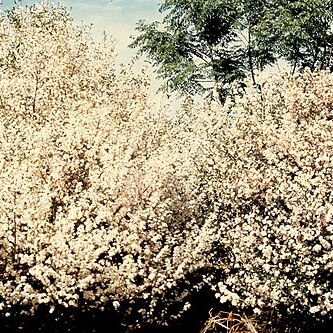Leaves deciduous, borne on young or less often mature stems or on short spurs; blades 2.2–7 × 1–3.4 cm, narrowly elliptic to broadly elliptic in shape, obtuse at the apex or rarely subacuminate, acute at the base, papery to subcoriaceous, usually slightly shiny above, with cellular pattern usually visible (with ×10 lens) on the surface, midrib prominent above, lateral and tertiary nerves apparent or somewhat obscure on both surfaces, marginal nerves apparent on lower surface only; lateral nerves in 4–6 main pairs; domatia with cavities incompletely or completely defined, sparsely pubescent to pubescent or occasionally absent; petiole 1–2.5 mm long; stipules 1.75–3.5 mm long altogether, triangular at the base, aristate above.
A small much-branched tree. It grows up to 6 m high. It often has a single stem. The leaves are shiny and in opposite pairs. They are 9 cm long by 6 cm wide. They are oval or sword shaped. They narrow to both ends. The edges are somewhat wavy. The flowers are 1.6 cm long by 1 cm wide. They are white with twisted petals. They occur in groups in the axils of leaves towards the ends of branches. The fruit are oval or round and about 1 cm long. They are red when ripe and contain 2 seeds. The seeds are grooved like other coffee beans.
Flowers 5–9(12)-merous, precocious or sometimes occurring with the leaves; 1(2) single-flowered inflorescences per axil or very occasionally with 2–3 flowers in a fascicled inflorescence; inflorescence stalks often covered with sticky exudate, 1–5 mm long, hidden by cupules or exposed; cupules 2–3, overlapping or not, with short foliar lobes; bracteolar cupule often present, ± truncate but deeply divided; bractlets scale-like, often numerous.
Fruit purplish to black when mature (or red fide Palmer & Pitman loc. cit. supr.), 9–11 × 6 mm; whole stalks lengthening to 4–7 mm long.
Corolla tube 6–12 mm long, 2–4 mm wide at top; lobes 6–13 × 2–7 mm, rounded.
Calyx limb shorter than or ± equalling the disk, repand to denticulate.
Shrub 1–3.5 m tall; young branches puberulous, with light brown bark.
Seed fawn-coloured, 5–7 × 3–4 mm.


